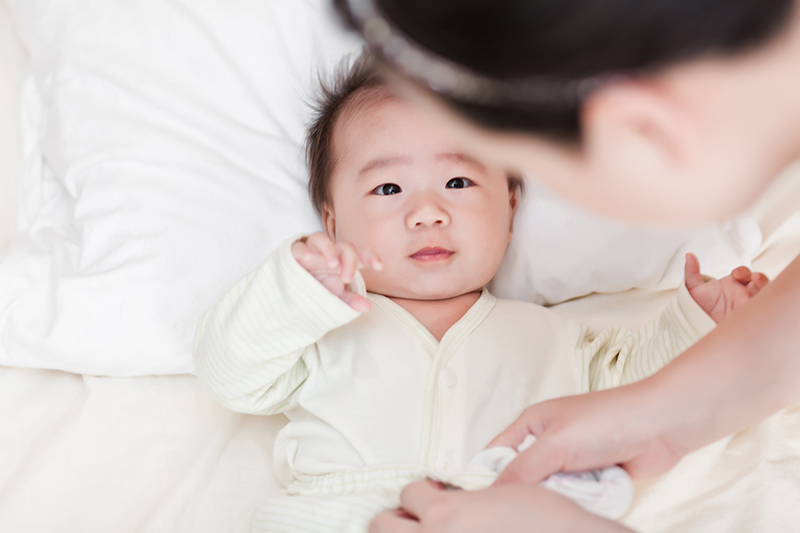Families For Life | Dressing Baby for Bed-Newborn

To sleep well and safely, babies need to be not too hot and not too cold. Our tips for dressing baby for bed help you get your baby’s temperature ‘just right’.
Dressing baby for bed: the basics
Choosing the right clothes
Dress your baby in enough warm clothes to keep her warm without blankets. Once she can roll over, she can get out from under the blankets and get cold. If you dress your baby in layers of fitted clothing, you can add or take away layers as the temperature changes.
When you’re dressing baby for bed, a handy tip is to think about what you’d wear to bed and use that as a guide.
Hats and beanies
Babies cool themselves down by releasing heat from their heads and faces. Your baby can quickly overheat if he falls asleep wearing a hat or beanie. So it’s important to keep your baby’s head uncovered when he’s asleep so that he doesn’t get too hot. Headwear in bed can also be a choking hazard.
Take off your baby’s hat or beanie when you go indoors or into any closed or warm space, like a car, so that she doesn’t overheat.
Baby’s temperature
Your baby’s hands and feet might feel cool, but this isn’t a good indication of his temperature. You can find out how hot your baby really is by feeling his back or tummy.
If you use a baby carrier or sling, keep in mind that your baby will be warmed by your body heat as well as by her clothes and wraps.
Room temperature
You don’t need to monitor the temperature in your baby’s room – just dress your baby as you would dress yourself.
If your baby’s room is too warm, you could use a plug-in floor fan to keep the room at a comfortable temperature. The safest place for a fan is on the opposite side of the room, away from your baby.
Never use electric blankets or hot water bottles to warm your baby up during colder weather.
Getting too hot has been linked with sudden unexpected death in infancy (SUDI) including SIDS and fatal sleeping accidents. Your baby should be comfortably warm – not hot, sweaty or cold.
Baby wrapping
Wrapping helps your baby settle for sleep, as well as stay in the safe sleeping position on his back.
If you choose to wrap your baby, it’s best to use lightweight cotton or muslin wraps. Make sure the wrap doesn’t go above your baby’s shoulders or cover her head, ears or chin. Wraps that are too high can obstruct your baby’s breathing and cause her to overheat.
Also check that there’s enough room for your baby to stretch his legs and that the wrap isn’t too tight around his chest and hips. Wrapping a baby’s legs and chest too tightly can lead to hip and breathing problems.
Babies can be wrapped from birth until they start showing signs that they can roll onto their tummies, usually around four months.
If you co-sleep with your baby don’t wrap her – she might get too hot. Dress baby as you would dress yourself.
Baby sleeping bags
A safe infant sleeping bag can be a good option for dressing baby for bed.
A correctly sized sleeping bag is the best way to keep your baby’s head and face uncovered, and helps reduce the risk of SUDI including SIDS and fatal sleeping accidents. It can also help stop your baby from rolling onto his tummy during sleep, and contain his legs so they don’t hang out through the cot’s rails.
If your baby needs extra warmth, you can put a single, lightweight blanket over the sleeping bag. Just make sure the blanket is firmly tucked in and doesn’t go past your baby’s chest.
Check that it’s impossible for your baby to slip down into the bag and become completely covered. It is recommended that you use a sleeping bag that has a fitted neck and armholes but no hood.
© raisingchildren.net.au, translated and adapted with permission
Explore more